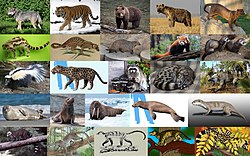| Carnivoramorpha | |
|---|---|

| |
| Diversity of Carnivoramorpha | |
| Scientific classification | |
| Kingdom: | Animalia |
| Phylum: | Chordata |
| Class: | Mammalia |
| Mirorder: | Ferae |
| Clade: | Pan-Carnivora |
| Clade: | Carnivoramorpha Wyss & Flynn, 1993[1] |
| Subgroups | |
|
[see classification]
| |
| Synonyms | |
Carnivoramorpha ("carnivoran-like forms") is a clade of placental mammals of clade Pan-Carnivora from mirorder Ferae, that includes the modern order Carnivora and its extinct stem-relatives.[4][5]
The common feature for members of this clade is the presence of the carnassial teeth. The carnassial teeth of the Carnivoramorpha are upper premolar P4 and lower molar m1.[6]
|
Recent phylogenetic studies indicate that the superfamily Miacoidea and family Miacidae are paraphyletic, with "miacids" being more closely related to carnivorans than to viverravids. In 2010 Flynn, Finarelli & Spaulding named a new clade Carnivoraformes within Carnivoramorpha, containing carnivorans and "miacids" but not viverravids.[7] The authors defined Carnivoraformes as the clade containing Carnivora and all taxa that are more closely related to Carnivora (represented by Canis lupus) than to viverravids (represented by Viverravus gracilis).
|